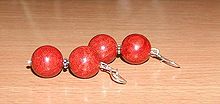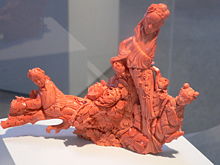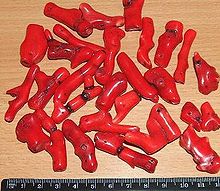- Precious coral
-
Precious coral 
Corallium rubrum Scientific classification Kingdom: Animalia Phylum: Cnidaria Class: Anthozoa Subclass: Alcyonaria Order: Gorgonacea Family: Coralliidae Genus: Corallium Precious coral or red coral is the common name given to Corallium rubrum and several related species of marine coral. The distinguishing characteristic of precious corals is their durable and intensely colored red or pink skeleton, which is used for making jewelry.
Contents
Habitat
Red corals grow on rocky seabottom with low sedimentation, typically in dark environments—either in the depths or in dark caverns or crevices. The original species, C. rubrum, is found mainly in the Mediterranean Sea. It grows at depths from -10 to -300 mt, although the shallower of these habitats have been largely depleted by harvesting.[1] In the underwater caves of Alghero, Sardinia (the "Coral Riviera") it grows at depth from -4 mt to -35 mt. The same species is also found at Atlantic sites near the Strait of Gibraltar and at the Cape Verde Islands.[1] Other Corallium species are native to the western Pacific, notably around Japan (Corallium japonicum) and Taiwan;[2] these occur at depths of 350 to 1500 m in areas with strong currents.[1]
Anatomy
In common with other Gorgonacea, red corals have the shape of small leafless bushes and grow up to a meter in height. Their valuable skeleton is composed of intermeshed spicules of hard calcium carbonate, colored in shades of red by carotenoid pigments.[1] In living specimens, the skeletal branches are overlaid with soft bright red integument, from which numerous retractable white polyps protrude.[3] The polyps exhibit octameric radial symmetry.
Species
The following are known species in the genus[4]:
- Corallium abyssale Bayer, 1956
- Corallium borneanse Bayer
- Corallium boshuense Kishinouye, 1903
- Corallium ducale Bayer
- Corallium elatius Ridley, 1882
- Corallium halmaheirense Hickson, 1907
- Corallium imperiale Bayer
- Corallium johnsoni Gray, 1860
- Corallium kishinouyei Bayer, 1996
- Corallium konojoi Kishinouye, 1903
- Corallium laauense Bayer, 1956
- Corallium maderense (Johnson, 1899)
- Corallium medea Bayer, 1964
- Corallium niobe Bayer, 1964
- Corallium niveum Bayer, 1956
- Corallium porcellanum Pasternak, 1981
- Corallium pusillum Kishinouye, 1903
- Corallium regale Bayer, 1956
- Corallium reginae Hickson, 1907
- Corallium rubrum (Linnaeus, 1758)
- Corallium secundum Dana, 1846
- Corallium sulcatum Kishinouye, 1903
- Corallium tricolor (Johnson, 1899)
- Corallium vanderbilti Boone, 1933
- Corallium variabile (Thomson & Henderson, 1906)
Coral as a gemstone
The Queen Farida of Egypt red coral parure by Ascione, manufacture, 1938, Neaples, Coral Jewellery Museum
 Non precious red dyed sponge coral earrings
Non precious red dyed sponge coral earrings
The hard skeleton of red coral branches is naturally matte, but can be polished to a glassy shine.[2] It exhibits a range of warm reddish pink colors from pale pink to deep red; the word coral is also used to name such colors. Owing to its intense and permanent coloration and glossiness, precious coral skeletons have been harvested since antiquity for decorative use. Coral jewelry has been found in ancient Egyptian and prehistoric European burials,[3] and continues to be made to the present day.
Precious coral has relative density of 3.86 and hardness 3.5 on the Mohs scale.[5] Due to its softness and opacity, coral is usually cut en cabochon, or used to make beads.
History of trade in coral
At the beginning of the Christian era, there was a great trade carried on in coral between the Mediterranean and India, where it was highly esteemed as a substance endowed with mysterious sacred properties. It is remarked by Pliny that, previous to the existence of the Indian demand, the Gauls were in the habit of using it for the ornamentation of their weapons of war and helmets; but in his day, so great was the Eastern demand, that it was very rarely seen even in the regions which produced it. Among the Romans branches of coral were hung around children's necks to preserve them from danger, and the substance had many medicinal virtues attributed to it. A belief in its potency as a charm continued to be entertained throughout medieval times; and even early in the 20th century in Italy was worn as a preservative from the evil eye, and by females as a cure for sterility.
From the Middle Ages upwards the securing of the right to the coral fisheries on the African coasts was an object of considerable rivalry among the Mediterranean communities of Europe. Previous to the 16th century they were controlled by the Italian republics. For a short period the Tunisian fisheries were secured by Charles V to Spain; but the monopoly soon fell into the hands of the French, who held the right till the Revolutionary government in 1793 threw the trade open. For a short period (about 1806) the British government controlled the fisheries, but later returned to the hands of the French authorities. Previous to the French Revolution much of the coral trade centred in Marseilles; but since that period, both the procuring of the raw material and the working of it up into the various forms in which it is used became peculiarly Italian industries, centering largely in Naples, Rome and Genoa.[6]
Coral in mythology
The origin of coral is explained in Greek mythology by the story of Perseus. Having petrified Cetus, the sea monster threatening Andromeda, Perseus placed Medusa's head on the riverbank while he washed his hands. When he recovered her head, he saw that her blood had turned the seaweed (in some variants the reeds) into red coral. Thus, the Greek word for coral is 'Gorgeia', as Medusa was one of the three Gorgons.[7]
Poseidon resided in a palace made of coral and gems, and Hephaestus first crafted his work from coral.
The Romans believed coral could protect children from harm, as well as cure wounds made by snakes and scorpions and diagnose diseases by changing colour.
Trivia
- The two biogenic precious gemstones, coral and pearl, although drastically different in appearance, are chemically very similar. Both are mostly calcium carbonate deposited by marine invertebrates.[2]
- Another unrelated species, the Hawaiian black coral is sometimes used as an ornamental material. Its skeleton is not mineralized, consisting mostly of conchiolin.
- In Hindu astrology red coral is associated with the planet Mars or Graha-Mangala and used for pleasing Mars. It should be worn in the ring finger.
- A branch of red coral figures prominently in the civic coat of arms of the town of Alghero, Italy.
See also
References
- ^ a b c d "Corallium species". ARKive. Archived from the original on 2007-06-20. http://web.archive.org/web/20070620223811/http://www.arkive.org/coral/Coral/corallium_more.html. Retrieved 2007-02-15.
- ^ a b c "Gemstones: Coral". Archived from the original on 2007-02-09. http://web.archive.org/web/20070209012329/http://www.gemstone.org/gem-by-gem/english/coral.html. Retrieved 2007-02-15.
- ^ a b "Red Coral". Marenostrum. http://marenostrum.org/vidamarina/animalia/invertebrados/cnidarios/corales/rojoi.htm. Retrieved 2007-02-15.
- ^ http://www.marinespecies.org/aphia.php?p=taxdetails&id=125325 accessed 29 June 2011
- ^ "Jewelry Central". http://www.jewelrycentral.com/Target_Coral.asp. Retrieved 2007-02-15.
- ^
 Chisholm, Hugh, ed (1911). "Coral". Encyclopædia Britannica (11th ed.). Cambridge University Press.
Chisholm, Hugh, ed (1911). "Coral". Encyclopædia Britannica (11th ed.). Cambridge University Press. - ^ "Passage from Ovid's Metamorphoses about the origin of coral". http://findarticles.com/p/articles/mi_m0422/is_2_81/ai_55174794/pg_34. Retrieved 2007-03-18.[dead link]
External links
- Red coral media at ARKive
- International Colored Gemstone Association Extensive info on gemstone coral and jewelry photos (Accessed 2 February 2007)
- American Gem Trade Association Information on coral as a gemstone (Accessed 2 February 2007)
- Organic Gems: Red Coral Jewelry Photos of raw coral material and coral jewelry (Accessed 2 February 2007)
- Mediterranean red coral: research team International Research Team on Mediterranean red coral (Accessed 15 March 2007)
- The state of red coral (Corallium rubrum) populations in the N.W. Sardinian fishing grounds(Accessed 16 September 2010)
- FAO
- Gemstones Guide: Coral
- All about red Coral Carvings
Corals and coral reefs Stony corals 
Soft corals - Alcyonacea
- Black coral
- Bamboo coral
- Organ pipe coral
- Sea fans
- Sea pens
Coral reefs - Atoll reef
- Cay
- Fringing reef
- Microatoll
- Coral reef fish
- Census of Coral Reefs
- The Structure and Distribution of Coral Reefs
Coral regions Coral diseases - Coral bleaching
- Black band disease
- Skeletal eroding band
- White band disease
- White pox disease
Protection - Coral reef protection
- Project AWARE
- Reef Check
- Reef Ball
- Coral Reef Alliance
- International Society for Reef Studies
Other - Artificial reef
- Coral aquaculture
- Coral dermatitis
- Coral (precious)
- Coral rag
- Coral sand
- Coralline algae
- Human impact
- Fire coral
- Rugosa (extinct)
- Tabulate (extinct)
- Zooxanthella
Categories:
Wikimedia Foundation. 2010.



